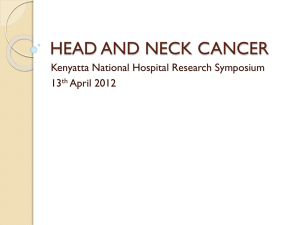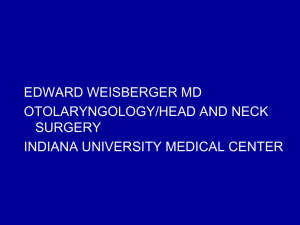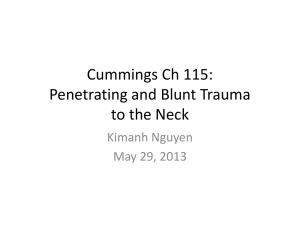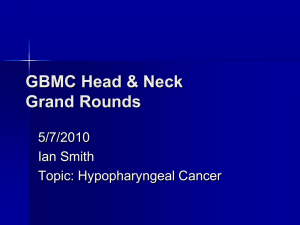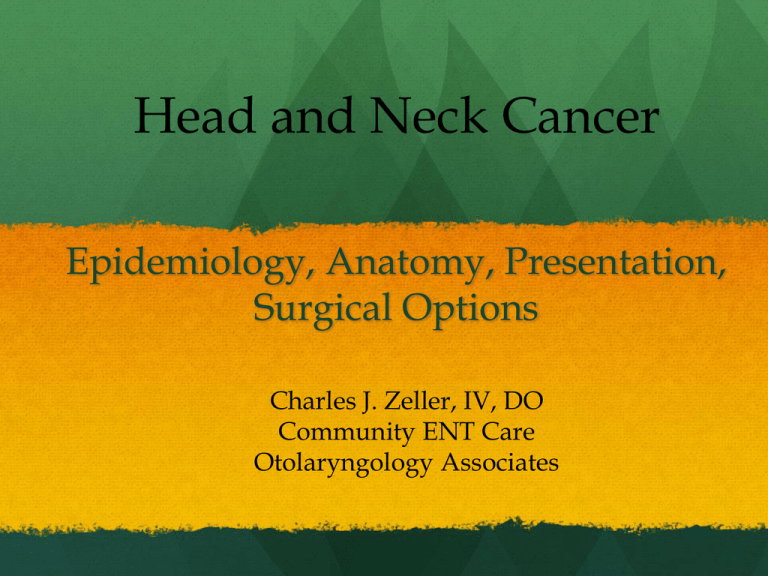
Head and Neck Cancer
Epidemiology, Anatomy, Presentation,
Surgical Options
Charles J. Zeller, IV, DO
Community ENT Care
Otolaryngology Associates
HNC: The Statistics
Cancer Cases and Deaths of the Oral Cavity & Pharynx by
Sex, United States, 2012
Men
Women
New Cases=28,540
New Cases=11,710
8th leading cause of
cancer in men
New Deaths=2,410
Lifetime probability
is 1 in 69
New Deaths=5,440
American Cancer Society. Cancer Facts & Figures 2012.
U.S. Incidence Rates for
HNC
In 2012, >40,000 new cases
Incidence more than
twice as high in men as
in women
From 2004 to 2008,
incidence rates declined
1.0% per year in
and were stable
by
women
in men
Incidence is increasing for oropharynx cancers
associated with human papillomavirus (HPV)
American Cancer Society. Cancer Facts & Figures 2012.
National Cancer Institute. A Snapshot of Head and Neck Cancer. October 2011.
U.S. Mortality Rates for
HNC
>7,850 deaths from oral
cavity and pharynx
cancer in 2012
Death rates have been
decreasing over the past 3
decades
From 2004 to 2008, rates
decreased by 1.2% per year
in men and by 2.2% per
year in women
American Cancer Society. Cancer Facts & Figures 2012.
National Cancer Institute. A Snapshot of Head and Neck Cancer. October 2011.
U.S. Survival Rates for
HNC
For all stages of HNC combined, about
84% survive 1 year after diagnosis
61% survive 5 years after diagnosis, and
50% survive 10 years after diagnosis
Five-year Relative Survival Rates by Stage at Diagnosis, 2001-2007*
Oral
cavity
&
pharynx
All
Stages
Local
Regiona
l
Distant
61%
82%
56%
34%
*Rates are adjusted for normal life expectancy and are based on cases
diagnosed in the SEER 17 areas from 2001-2007, followed through 2008.
American Cancer Society. Cancer Facts & Figures 2012.
Relative Survival Rate (%) by
Primary HNC Site, 1988-2001
Piccirillo JF, et al. National Cancer Institute. SEER Survival Monograph. Chapter 2
HNC Risk Factors
Known risk factors:
All forms of smoked and
smokeless tobacco
products
Excessive consumption of
alcohol
30-fold increased risk for
individuals who both
smoke and drink heavily!
HPV infection associated
with cancers of
Tonsil
Base of tongue
Other sites within the
oropharynx
Believed to be transmitted
through sexual contact
American Cancer Society. Cancer Facts & Figures 2012.
Smoking-Associated HNC
American Cancer Society. Cancer Statistics 2012.
Tobacco Use and Related
Cancers on the Decline
American Cancer Society. Cancer Statistics 2012.
Diagnosis and Staging
Head and Neck Cancer (HNC)
Oral cavity
Nasal antrum
Lip
Buccal mucosa
Alveolar ridge and
retromolar trigone
Floor of mouth
Hard palate
Oral tongue
(anterior two thirds)
Larynx
Supraglottis
False cords
Arytenoids
Epiglottis
Arytenoepiglottic fold
Glottis
Subglottis
Nasopharynx
Oropharynx
Base of tongue
Soft palate
Tonsillar pillar
and fossa
Hypopharynx
Esophagus
Pharynx
Anatomy
Cervical Lymph Nodes
Anatomy: Nasopharynx
Eustachian tube
Torus Tubaris
Fossa of Rosenmuller
Anatomy: Oro/Hypopharynx
From the uvula to hyoid bone
Palatine tonsils, tonsillar pillars
Base of tongue
Epiglottis and vallecula
Anatomy: Laryngopharynx
From the epiglottis to the inferior cricoid cartilage
Vocal cords, piriform sinuses, arytenoid cartilage and
aryepiglottic folds
Head and Neck Cancer
Signs and Symptoms
Persistent hoarseness
Palpable mass in neck
Branchial cleft cysts rarely present later than young adulthood
Neck mass in persons >40 yrs of age should be considered a malignancy until proven
otherwise
Ear infection or pain
Altered oral sensations or persistent sore throat
Lesions in mouth
Erythroplasia (early red lesions)
Leukoplakia (white lesions)
Persistent mass or ulcer (usually oral cavity)
Difficulties in chewing, swallowing, or moving the tongue or jaws are often late symptoms
Chin D, et al. Expert Rev Anticancer Ther. 2006;6:1111-1118.
NCCN Clinical Practice Guidelines. Head and Neck Cancers. V2. 2011.
American Cancer Society. Oral Cavity and Oropharyngeal Cancer, Laryngeal and Hypopharyngeal Cancer.
Head and Neck Cancer
Typical Presentation
Symptoms include:
Persisting hoarseness
Dysphagia
Hemoptysis
Throat pain
Ear pain
Airway compromise
Unexplained aspiration
Neck mass
Weight loss
Larynx Cancer
Presentation
Hoarseness is the most common symptom
Sore throat or cough that does not go away
Patients presenting with new onset or worsening
hoarseness should undergo indirect mirror exam
and/or flexible laryngoscopy
Videostroboscopy may be recommended
Good neck exam, look for cervical adenopathy
Palpate base of tongue for masses
HNC Evaluation
Inspection and palpation
Biopsy of any suspicious mucosal surface
Imaging
CT, MRI
Barium swallowing study
PET/CT of value in identifying neck disease and unknown primaries
CT of chest if there are neck nodes and no PET/CT as lung metastases
common first distant site
New cystic lesion in the neck unlikely to be recent onset branchial cleft
cyst in an adult
FNA of lymph node
Examination under anesthesia
Full evaluation of the areas at risk
NCCN Clinical Practice Guidelines. Head and Neck Cancers. V2. 2011.
American Cancer Society. Oral Cavity and Oropharyngeal Cancer, Laryngeal and Hypopharyngeal Cancer.
Premalignant changes
Presentation: Nasopharynx
Oral Cavity Cancer
Presentation
Tongue cancer
Presentation: Oropharynx
Globus sensation
Difficultly swallowing
Slurred speech
Pain in throat or ear
Neck mass
Presentation: Larynx
Hoarse voice
Stridor
Cough, hx of GERD
Trouble swallowing
For glottic tumors
T1-2 5% LN involvement
T3-4 20% LN involvement
Histopathology
Considerations for HNC
Premalignant lesions
Leukoplakia
Erythroplakia
Squamous dysplasia
Lichen planus
Carcinoma in-situ (CIS) and early invasive
squamous cell carcinoma (SCC)
Atypical squamous cells exhibiting nuclear atypia
Increased nuclear-to-cytoplasmic ratio
Varying degrees of keratinization
Park BJ, et al. Cancer Biomark. 2010;9:325-339.
Histology
90% of H&N cancers are squamous cell carcinomas
arising from the mucosal surfaces
Salivary gland tumors are typically adenocarcinomas
How To Treat Head and
Neck Cancer
Find it, usually late
-over 80% of tumors are late stage
Surgery (cut it out)
Radiation (burn it)
Chemotherapy (selective poisoning)
Combine the above
Head and Neck Cancer
Management
Multimodality therapy for all but very early stages:
surgery, radiation with adjuvant chemotherapy
Significant morbidity due to therapy is possible:
cosmesis, decreased saliva, swallowing dysfunction,
social dysfunction
Novel molecular directed therapies incorporated into
next generation trials
Oral Cavity/Oropharynx Surgical
Approaches
Transoral
Visor
Lip Split with or without mandibulotomy
Lip Split with Mandibulectomy
Oral Cavity/Oropharynx
Surgical Approaches
Transoral and Visor Approaches
Cosmetic but may limit exposure
Lip Splitting
Modest cosmetic disadvantage with excellent
posterior exposure for mandibulotomy
Paramedian or midline mandibulotomy
Avoidance of alveolar nerve
Primary Surgery + Radiation Indicated
for Advanced Oral Cavity Cancer
Low local control for primary radiotherapy for
advanced oral cavity (30-40%) and poor survival
(25%)
Increased local control with surgery +
radiotherapy (60%) and improved survival (55%)
Zelefsky et al, Head Neck. 1990 Nov-Dec;12(6):470-5
Local control significantly improved for locally
advanced T3, T4 oral cancers using surgery +
postoperative radiotherapy vs. primary RT
Fein et al. Head Neck. 1994 Jul-Aug;16(4):358-65
Surgical Resection
Advances
Reconstruction
Free Tissue Transfer
Mandibular reconstruction (fibula, scapula, etc.)
Soft tissue/tongue (radial forearm, rectus
abdominus, lateral thigh, etc.)
Resection is rarely limited by size or extent of
tumor
Surgical Management Options-Role for Minimally Invasive
Approaches?
Transoral laser microsurgery or robotic assisted
surgery may be utilized in select patient
populations
Selected tumors of oropharynx and larynx
HPV demographic
Quicker recovery, faster return to swallowing,
decreased rates of tracheostomy and gastrostomy
tube dependence.
Disease free/survival outcomes appear equal to that
offered by primary chemoradiation
Transoral Robotic Assisted
Surgery--TORS
Concept of De-Intensification of Therapy through TORS
Currently only in clinical trial setting
Await the data??
15-30 % of patients avoid radiation
Significantly lower doses and focused treatment fields
when used.
40-70 % patients avoid chemotherapy
Reduced rate of PEG dependency
Survival statistics equal to or surpassing other modalities
Surgical Management of
Laryngeal Malignancy
Premalignant lesions or Carcinoma in situ can be
managed by surgical excision/stripping of the
entire lesion
CO2 laser can be utilized
Early stage (T1 and T2) can be treated with
radiotherapy or surgery alone, both with 85-95%
cure rate
Surgery has shorter treatment period but may have
poorer voice outcomes
Surgical Management of
Laryngeal Malignancy
Advanced stage lesions often receive surgery
followed by adjuvant radiation therapy
Most T3 and T4 lesions require a total
laryngectomy/pharyngectomy
Reconstruction of aerodigestive tract with locoregional flap or free tissue transfer
Some small T3 and lesser sized lesions can be
managed by partial laryngectomy
Surgical Management of
Laryngeal Malignancy
Modified or radical neck dissection is indicated in the
presence of known nodal disease or locally advanced
tumors
N0 necks can have a selective neck dissection sparing
SCM, IJV, and CN XI
Supraglottic and subglottic tumors have higher rate of
occult cervical metastasis due to lymphatic drainage
patterns
Extension to subglottic space associated with a higher
incidence of stomal recurrence following total
laryngectomy
Voice Rehabilitation After
Laryngectomy
Tracheoesophageal voice prosthesis
Electrolarynx
Pure esophageal speech
Role of speech and language
pathologist for rehabilitation
Case Presentation
73 Y edentulous farmer with a right gingival
lesion, otherwise asymptomatic
120 PY smoking history, currently smoking
Past Medical History: diabetes, coronary artery
disease, myocardial infarction x 2, carotid
endarterectomy, peripheral vascular disease,
and hypertension, renal insufficiency
Exam shows a right lower gingival mass, 2.5 cm
squamous cell carcinoma
Case Presentation
CT demonstrates R mandibular invasion
Case Presentation
PET/CT demonstrates no evidence of metastasis
MR angiography demonstrates severe peripheral
vascular disease in bilateral lower extremities
Case Presentation
Therapy
Resection from paramedian to angle of mandible to
encompass alveolar nerve
Case Presentation
Treatment Options
T4N0M0 squamous cell carcinoma of the right alveolus
Right mandibulectomy (via visor flap), right neck
dissection, fibula free flap, tracheotomy, postoperative
radiation and chemotherapy
Transoral mandiblectomy, postoperative radiation to
primary site and ipsilateral neck
Case Presentation
Outcome
Oral alimentation at 5 days postop
External beam radiation to primary and ipsilateral neck
onset 3 weeks post surgery
Acceptable cosmetic appearance
NED at 30 mo, died shortly after from MI
Questions?
Contact:
Charles J. Zeller, IV, DO
Community ENT Care
Otolaryngology Associates
317-844-7059
czeller@otolaryn.com
Thank You!



